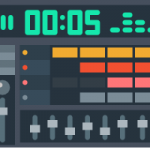目次
4.Listen to Blk
OK, a long way preparation is now done. Let’s listen to Blk chords!
①Wholetone Type
Wholeton Scale has all the Blk intervals in it so you can put Blk whenever you play this scale.
This is an example of wholetone scale song. Now change this piano backing all to Blk!
No incongruity at all😉 Since wholetone scale itself has as a strange type of sound, it’s quite natural for Blk to stay there.
Instances
The real instance of this type is “Guilty Eyes Fever”.
In this part the melody plays “mi-re-do”. Utilizing this wholetone line, wholetone scales & Blk chords are eccentrically interplated. Really shocking usage!
②Slashed Chord – (1)Transitional Chord
In the short moment when the upper part and the bass part moves in contrary motion, Blk may appear.
Especially during I-IV or V-IV motion, ♯IV Blk can easily happen to arise.
This is it. the bass going down & the upper triad going up, very smooth motion.In classical terms, these kind of chords are called “transitional chord“.
Instances
Many of those with root at ♯IV seems to have this origin.
Donna Tokimo
Listen to the chord just before the chorus. The strings going up & the bass going down, which creates the structure of ♯IV Blk.
②Slashed Chord (2)Flipped Bass
Another one listed in “slashed chord type” is an Aug chord with its bass flipped tritone away. It’s similar to “(1)Transitional Chord” type but it’s distinct in :
- it sustains longer than transitional chords (like 1 bar)
- Phrases are regularly played without stepwise-double-contrary-motions.
- Its idea is associated more with Jazz theory;”Tritone Sub” & “Playing Outside”, than classical theory.
Tha last one is important since the meaning, intention or orientation is one important material you should consider when analyzing music.
Instances
Sekai wa Sore wo Ai to Yobundaze
In the riffs in Intro or Verse, the second chord is “Aaug/D♯“.
This is such a straight rock song that it’s rather natural to interpret it as the mixture of the guitarist simply playing Aaug & the bassist somehow playing D♯ just to make it fun, than to see it as “Dominant 9th (+11)”.
Since these “Slashed Chord Type Blk” arise from the independence between upper chord & bass, it’s not a good idea to suppose they all play the same single scale. In this case, the vocalist ignores all these strange chords and sing his melody within A major scale.
Syakunetsu Switch
This is a crazy song whose chorus part starts withIII+/VII!
In this case, the composer himself declare (in Twitter) that he flipped the bass tritone away.
This “tritone flip” technique is common especially in Jazz realm. Such tricky ideas make Blk happen.
③Tension Chord Type – (1)domi9
On the other hand, there’re cases where you should see Blk not as a slashed chord, but as a tension chord.
A little twist can transform Dominant 9th Chords into Blackadder Chords.
In these cases, refilling the omitted 3rd will sound very very very natural, which will be one of the criteria for categorization.
Instances
While instances of “Slashed Chord Type” can be found relatively in pops/rock genre, those of this type is closer to Jazz, since they are high-level tension chords.
Ohayo, Mata Ashita
This is a song from K-On!, our everlasting fairytale anime!! This is obviously derived from the Tritone Sub ♭II7 interpolated between ii-V-I progression.
I couldn’t find other examples, so I made some with other roots as samples.
- IIm7IIIm7VIm7VIblk
In this case, Taking the tritone as ♯11th, P5th is included in the scale. ♯11th works like a blue note (minor 3rd of the key), making it naturally incorporated.
If VI is flipped tritone away, it becomes ♭III7blk.
- IIm7IIIm7VIm7
IIIblk
Since this can be interpreted as both “Tension Chord Type” & “Slashed Chord Type”, it’s based upon double contexts, which seems to make it sound really smooth despite its strange chord tone members.
- VIm7
IV
IVblkIII7
Lastly, IV7, the tritone sub of VII7, turned into blk. In this case the tritone is taken as +4 and I played P5 (so the actual chord name is IV9(+11)omit3). If you take it as o5 and use P4 instead of P5, it will also make good results.
- VIm7
IV
IVblkIII7
This is it. P4 & o5, entailing the flavour of a blue note. In this case the actual chord name is IV9(-5)omit3.
③Tension Chord Type – (2)Half Dim.
Not only Dominant 9th chords but also any Half Diminished Chords can easily turn into Blk chords.
I explained ♯IVblk in the “Slashed Chord Type” section above, but viewed from different perspective, it has Half Dim context as well.
I suppose; we are so familiar to ♯IVø that we can easily accept ♯IVblk.
♯IVblk is the only instance I could find in this “Half Dim Type”, but if you try the same thing in other roots like VII or III (we’re also accustomed to VIIø, IIIø), you’ll be convinced that it’s possible.
- VIm7IIm7VIIblkIII7VIm7IVΔ7VIIblkIII7
(Note that chord degrees are based on major key.)
This is an example. The “minor ii-V progression” is replaced by Blk. You may hardly hear the difference, don’t you?
- IIm7V7IIIblkVI7
Also natural. Our well-known IIIø with just one altertation. So any Half Dim Chords is readily interchangeable with Blk!
Japanese Augmented Sixth
People in classical music find similarity between this ♯IVblk and “Italian Sixth” or “German Sixth”, and propose to call it “Japanese Sixth”.
Regarding the "Blackadder" ("Ikisugi") Chord, I'd like to propose a formal name more fitting for analysis: "Japanese Augmented 6th" (abbreviated "Jpn+6" or "Jp+6").
Here, I've shown the prototypical example. Resolves to major or minor chord a semitone below, usually IV. pic.twitter.com/DIetxQix6j
— Atelier Joshua (@joshuataipale) February 28, 2019
Classical music theory handles the interval “augmented 6th”, which is enharmonically equal to minor 7th. The classic world distinguishes between these two, just like you do between ♯11th and ♭5th.
Though most of the instances of blackadder chords should be seen as “seventh” rather than “augmented 6th”, some really are a kind of augmented sixth chords.
Typically, “Japanese Sixth” is followed by dominant chords, just like other augmented sixth chords. “Japanese Sixth” has a scent of wholetone scale, so it is no wonder that early 20th century composers love this sound.
On the 3rd bar comes the chord “G♭-B♭-C-E-A♭”. B♭ is redundant for “Japanese Sixth”, but you can still hear the distinct sound of augmented triad.
Addendum
This time I analyzed Blk chords with the items you find only within popular music fields. If you look around Jazz/Classic realm, there’re still more findings.
From “Mystic Chord”
For example, the “Mystic Chord”, which Scriabin creates loved to use, has the exact interval of Blk :Rt,M2,+4,m7.
Scriabin use this chord on Piano Sonata No.5 (1907).
- Sonata no. 5, Op 53 (mm.263-264)
Left hand arpeggio is the mystic chord. And going back another 4 years, you can find some prototype for mystic chord, which happens to resemble Blk chord.
- Sonata no. 4, Op 30 (mm.6-7)
I cropped 6-7 bars, please listen to bar 7。First comes Rt・M3・M9, then +4. Though M3rd is redundunt, it can be seen as an ancestor of Blk. This song is composed in 1903. So some song around these period might be the very oldest example of Blk chord🤣 That said, maybe you can find one even in Chopin’s period.
From Jazz
From Jazz perspective, You can find RtM2+4m7 in the sixth mode of Melodic Minor Scale.
But anyway, I’m gonna stay within popular music field, because the very point you should focus is that It is J-Pop that seems to love to use this chord.




